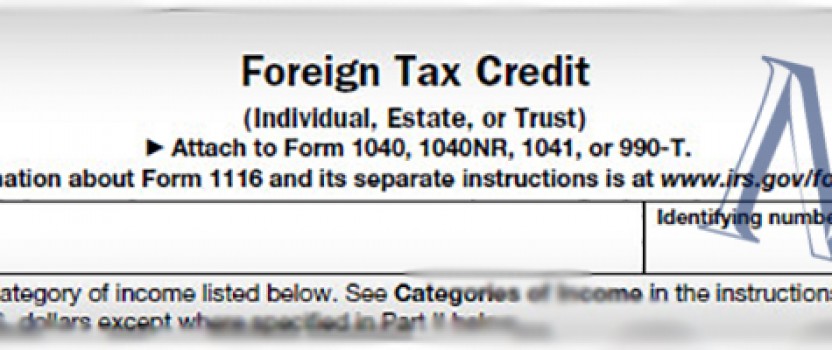Foreign Tax Credit Compliance Tips
Foreign Sourced Qualified Dividends and Gains
If you have received foreign sourced qualified dividends and/or capital gains (including long-term capital gains, unrecaptured section 1250 gain, and/or section 1231 gains) that are taxed in the U.S. at a reduced tax rate, you must adjust the foreign source income that you report on Form 1116, line 1a.
How do I make the adjustment?
- Form 1116 Instructions – See the detailed instructions for “Foreign Qualified Dividends and Capital Gains (Losses)”.
- Generally, if the foreign sourced income was taxed at the 0% rate, then you must exclude the income from your foreign source income (Form 1116 line 1a).
- Generally, if the foreign sourced income was taxed at the 15% rate, then you must multiply that foreign sourced income by 0.4286 and include only that amount in your foreign source income on Form 1116, line 1a.
I received a Schedule K-1 that reports qualified dividends and/or capital gains and foreign source income. What amount do I include on Form 1116, line 1a as foreign source income?
- The flow through entity should provide details of any qualified dividends and/or capital gains that have been included on the Foreign Transaction reporting (Partnership Schedule K-1 line 16 or S Corporation Schedule K-1 line 14) as income to be sourced at the partner level or foreign income already sourced at the partnership level.
- If Schedule K-1 reports qualified dividends and/or capital gains and foreign source income, but does not provide the necessary detail to determine the amount of the qualified dividends and/or capital gains that is foreign source income, you should contact the partnership or S corporation for the necessary details.
- Any foreign sourced qualified dividends and/or capital gains reported on Schedule K-1 will require the adjustments discussed above in “How do I make the adjustment?.”
Interest Expense Apportioned
You must apportion interest expense between the U.S. and foreign source income using an asset method. See Publication 514 for more information on the asset methods.
Am I required to apportion interest expense even if I borrow the money in the U.S.?
Yes. Money is fungible – it can be borrowed anywhere, and it can be spent or invested anywhere and for any purpose. For this reason, you are required to apportion all interest expense between the U.S. and foreign source income.
What types of interest expense am I required to apportion?
All interest expense must be apportioned against both the U.S. and foreign source income. This includes home mortgage interest, business interest, investment interest expense, passive activity interest, and partnership interest.
Is there a de minimis exception to the interest apportionment rules?
Yes. If you are a U.S. citizen, resident alien, or a domestic estate, and your gross foreign source income (including any income excluded on Form 2555 or Form 2555-EZ) does not exceed $5,000, you can allocate all of your interest expense to U.S. source income.
Where do I report the apportioned interest expense?
Interest expense that has been apportioned to foreign source income is reported on Form 1116, lines 4a and 4b.
My Schedule K-1 reports interest expense. How do I apportion that?
- You must apportion the interest expense that has been reported on Schedule K-1, line 16g (partnership) and line 14g (S corporation).
- See Publication 514 for the general rules on apportioning interest expense that has been reported to you on Schedule K-1.
Charitable Contributions
Do I need to apportion charitable contributions against foreign source income?
No. Charitable contributions DO NOT reduce your foreign source income. Do not report them on Form 1116.
Foreign Tax Withheld and Income Tax Treaties
The amount of foreign tax that qualifies as a credit is not necessarily the amount of tax withheld by the foreign country. If you are entitled to a reduced rate of foreign tax based on an income tax treaty between the U.S. and a foreign country, only that reduced tax qualifies for the credit. Include on Form 1116 line 8 ONLY the amount of creditable taxes. Amounts for which you are not legally liable (such as taxes in excess of the treaty rate) should be excluded from the amount reported on line 8.
Tools and Links
For more information on claiming a foreign tax credit, the following information is available:
International Information on irs.gov
How to Figure the Foreign Tax Credit
Publication 514 Foreign Tax Credit for Individuals
Publication 901 U.S. Tax Treaties
Form 1116 Foreign Tax Credit
Form 1118 Foreign Tax Credit – Corporations





Most Commented Posts